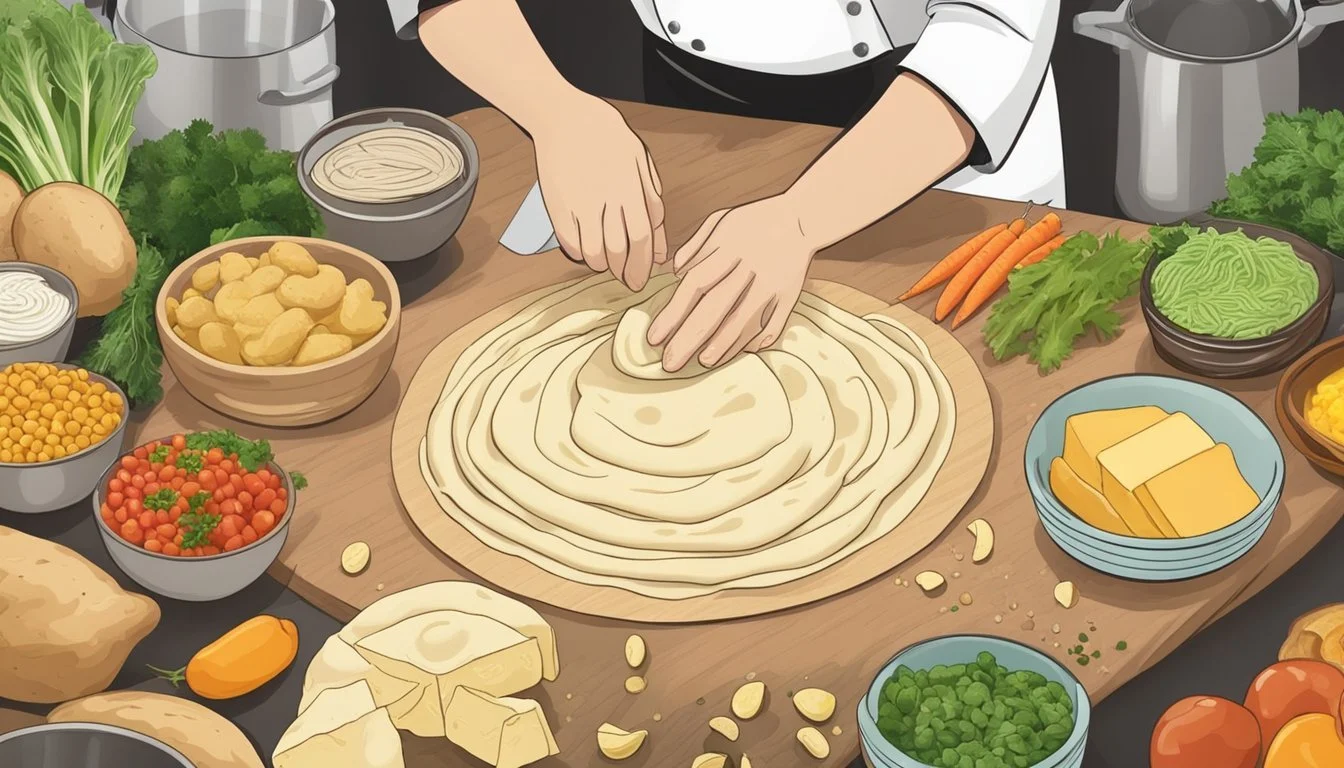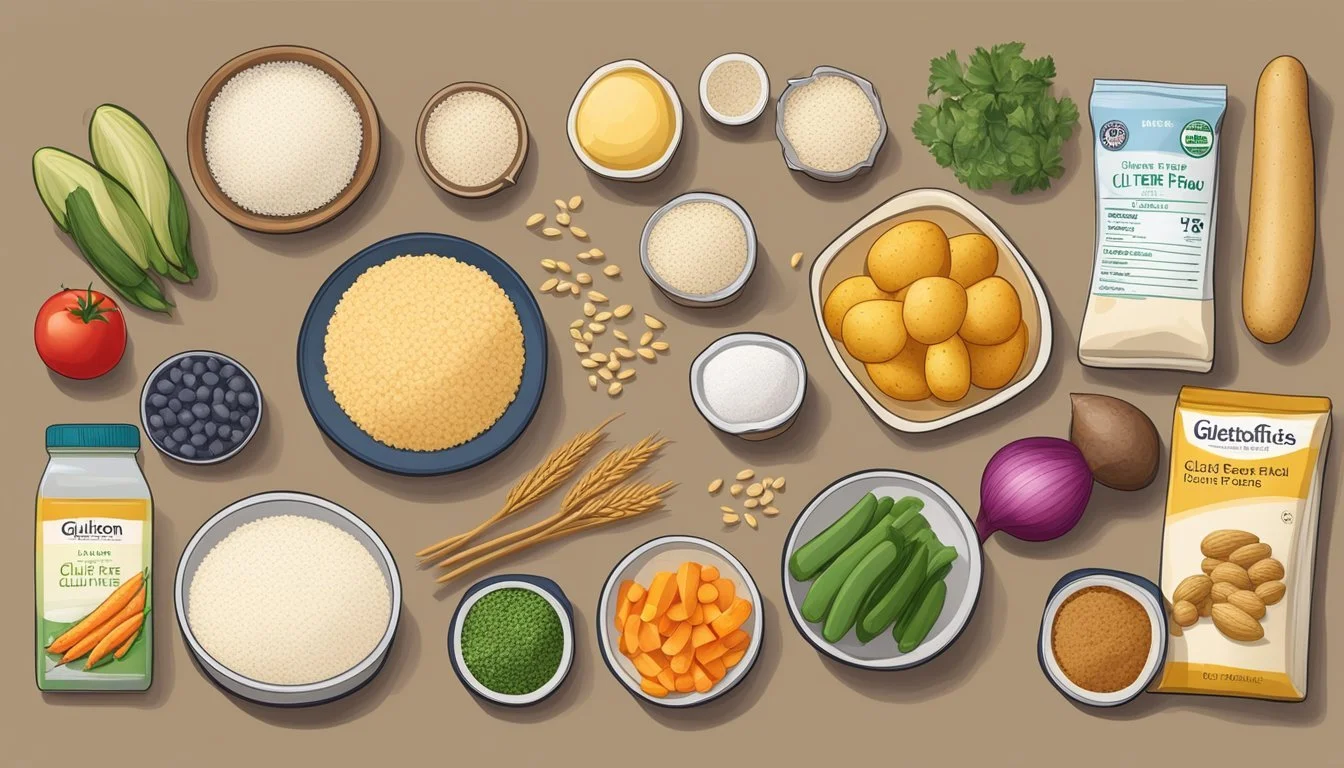Are Pierogi Gluten-Free?
Assessing Traditional and Modern Variations
Pierogi, traditional Polish dumplings, typically come packed with a variety of fillings ranging from savory to sweet. Although these stuffed delights are a staple in many Eastern European cuisines, questions often arise about their compatibility with gluten-free diets. The classic pierogi dough is made with wheat flour, rendering it unsuitable for those with celiac disease or gluten sensitivity. However, the increasing demand for gluten-free options has led to adaptations of this Eastern European favorite to cater to a wider audience.
In response to dietary restrictions and preferences, numerous gluten-free pierogi recipes and commercially available options have emerged. These gluten-free variants substitute wheat flour with alternative gluten-free flours, such as rice flour or bespoke blends specifically designed to mimic the texture and elasticity of traditional dough. Accommodating the need for gluten-free choices, these pierogi still strive to maintain the authenticity of their flavors and textures. It's essential for those seeking gluten-free pierogi to thoroughly examine ingredients and preparation methods to ensure they meet gluten-free standards.
Understanding Gluten-Free Diets
A gluten-free diet is essential for individuals with celiac disease, which is an autoimmune disorder where the ingestion of gluten leads to damage in the small intestine. Gluten is a mixture of proteins found in wheat, barley, rye, and triticale. When a person with celiac disease consumes gluten, their body mounts an immune response that attacks the small intestine, causing symptoms such as abdominal pain, diarrhea, and bloating.
Key Aspects of a Gluten-Free Diet:
Total avoidance of gluten: It is crucial to check for gluten in various food products, as it is often present in many processed foods and beverages.
Reading labels: Legally, foods labeled "gluten-free" must contain less than 20 parts per million of gluten.
Cross-contamination: There is a need for vigilance in kitchens and eateries to avoid cross-contamination with gluten-containing foods.
Alternatives Allowed in a Gluten-Free Diet:
Grains: rice, corn, millet, and quinoa.
Flours: almond flour, coconut flour, and rice flour.
Additionally, those who do not have celiac disease but experience sensitivity to gluten may also benefit from a gluten-free diet. This condition is referred to as non-celiac gluten sensitivity, and individuals report alleviation of symptoms when following a gluten-free diet.
A gluten-free diet is not a weight-loss regimen but rather a dietary requirement for those with gluten-related disorders. Ensuring adequate nutrition is vital, as gluten-free products can be lower in certain vitamins and minerals. Consulting a healthcare professional or a dietitian can support individuals in managing a balanced gluten-free diet.
What Are Pierogi?
Pierogi are a staple of Eastern European cuisine, often associated with countries such as Poland, Ukraine, and Slovakia. They are a versatile and beloved comfort food that can be enjoyed as an appetizer or a main dish, making them a common presence in family gatherings and traditional celebrations.
Traditionally, pierogi are dumplings made from a simple dough of flour and water, sometimes with an egg added for elasticity. The dough is rolled thin and cut into circles, then filled with a variety of ingredients before being sealed by pinching the edges together.
Typical fillings include:
Mashed potatoes
Cheese (often cottage or farmer's cheese)
Sautéed onions
Cabbage
Mushrooms
Meat
Cooking methods vary, with the most common being boiling until they float to the top of the water. Once boiled, they can also be pan-fried to add a crispy texture to the otherwise tender dumpling.
In Eastern European cultures, pierogi are more than just food; they are a culinary tradition passed down through generations. Each family may have its own special recipe or preferred filling, underscoring the personal touch that often accompanies the preparation and enjoyment of pierogi.
Though pierogi are not inherently gluten-free due to the wheat flour typically used in the dough, gluten-free versions can be crafted using alternative flours. This ensures that even those with gluten sensitivities can appreciate this traditional dish.
The Importance of Gluten-Free Dough in Pierogi
For individuals with gluten sensitivities, the creation of gluten-free pierogi dough is not just a preference, but a necessity. It allows them to enjoy traditional pierogi without the adverse health effects caused by gluten. The quality and characteristics of the gluten-free dough are pivotal to achieving a palatable texture and taste that closely resembles that of traditional pierogi.
Selecting the Right Gluten-Free Flour Blend
Selecting an appropriate gluten-free flour blend is crucial for the success of gluten-free pierogi dough. The flour blend often includes ingredients like brown rice flour, sweet rice flour, and tapioca starch. This combination is designed to mimic the properties of gluten, providing structure and elasticity to the dough. It is important to ensure that the flour blend has a balanced composition to avoid grittiness or a dense final product.
Role of Xanthan Gum in Gluten-Free Dough
Xanthan gum is a key ingredient in gluten-free doughs, serving as a substitute for gluten. It acts as a binder, helping to hold the dough together and giving it the flexibility needed to wrap around fillings without cracking. Typically, recipes call for 1 to 2 teaspoons of xanthan gum to achieve the desired consistency. However, the exact amount may vary depending on the specific flour blend used.
Preparing Gluten-Free Pierogi Dough Textures
Achieving the right texture in gluten-free pierogi dough requires careful preparation. The dough should be malleable yet firm enough to maintain its shape during boiling and frying. Ingredients are usually mixed until they come together in a sticky mass. At this point, dough is often divided into smaller portions and rolled out on a surface lightly dusted with gluten-free flour to prevent sticking. A well-made gluten-free pierogi dough should be pliable and easy to work with, providing a delicate exterior to the savory or sweet filling it encases.
Making Gluten-Free Pierogi at Home
Creating pierogi at home without gluten is entirely feasible with the right ingredients and techniques. This section details steps for a gluten-free recipe, boiling and frying methods, and tips for preserving these homemade delights.
Gluten-Free Pierogi Recipe Steps
Ingredients Preparation: Begin by combining water with psyllium husk, letting it sit until a gel forms, which replaces gluten's binding property.
Dough Making: In a large bowl, thoroughly knead a mixture of gluten-free flour, psyllium gel, salt, and eggs to form the pierogi dough.
Filling and Shaping: Choose a filling that complements the neutral flavor of the dough. Common fillings include cheese, potatoes, or meats. Use a cookie cutter to shape the pierogi after rolling out the dough on a gluten-free floured surface.
Boiling and Frying Considerations
Boiling Process: Cook pierogi in a pot of boiling water until they float to the top, generally for a few minutes, using a slotted spoon for transfer.
Frying for Texture: Post-boiling, heat a skillet with olive oil and fry pierogi on both sides until they achieve a golden-brown crispiness.
Tips for Preserving Gluten-Free Pierogi
Make-Ahead: Pierogi can be made in advance and stored in the fridge for several hours before cooking.
Freezing: To freeze, lay out the freshly made, uncooked pierogi on a baking sheet, and once frozen, transfer them to a sealable bag for long-term storage.
Reheating: Reheat by boiling or frying directly from the freezer, increasing the cooking time to ensure thorough heating.
Versatile Gluten-Free Pierogi Fillings
The fillings for gluten-free pierogies offer a diverse range of flavors, from the traditional potato and cheese to innovative sweet and savory options, catering to various dietary preferences.
Classic Potato and Cheese Filling
A timeless favorite, the classic potato and cheddar cheese filling remains a cornerstone for gluten-free pierogi. To make this filling, one needs to combine mashed potatoes with grated cheddar cheese, seasoning the mixture with salt and pepper to taste. For a creamier texture, a dollop of sour cream can be added. Some cooks opt to incorporate sauteed onions for additional depth of flavor.
Creating Sweet and Savory Filling Variations
Diversifying pierogi fillings caters to both the sweet and savory palate. For savory options, ingredients like sauerkraut or vegan cheese substitutes can be used to create unique combinations. As an example:
Sauerkraut Filling: Mix well-drained sauerkraut with sauteed onions, and add a spoonful of sour cream for a tangy, rich stuffing.
For the sweet tooth:
Sweet Potato Filling: Sweet potatoes, mashed and seasoned with a hint of cinnamon and nutmeg, can serve as a delicious base for those seeking a subtle, naturally sweet filling.
In both cases, the fillings can be enhanced with various sauces or a side of sour cream to complement the pierogi's flavor profile. Customizing fillings allows for a range of dietary accommodations, including vegan preferences, by carefully selecting plant-based ingredients.
Serving and Enjoying Gluten-Free Pierogi
Gluten-free pierogi can be just as delightful as their traditional counterparts when served with the right accompaniments and prepared as an appetizer or main dish. Choices of toppings and how they are presented can make gluten-free pierogi a versatile option suitable for various dining occasions.
Accompaniments and Toppings
When serving gluten-free pierogi, toppings play a crucial role in enhancing flavor. Sour cream is a classic choice, often served on the side for dipping or dolloped on top. Butter can be melted and drizzled over the pierogi to add a rich, silky finish. For an added texture and flavor, onions and bacon can be cooked until crisp and sprinkled on top. Caramelized onions provide a sweet and savory note that complements the soft filling of the pierogi. Additionally, a drizzle of olive oil can be used to sauté or simply to finish the dish, giving it a fruity undertone.
On the Side:
Sour cream
Melted butter
Toppings:
Crisp bacon bits
Sautéed or caramelized onions
Pierogi as an Appetizer or Main Dish
Gluten-free pierogi's versatility allows them to shine as both an appetizer or a main dish. As appetizers, they might be served in a smaller portion, often five to six per person, and can be accompanied by light sides such as a green salad or sliced vegetables. When featured as the main course, the pierogi are commonly presented in larger quantities and might be combined with more substantial sides like roasted meats (What wine goes well with roasted meats?) or vegetables. The preparation method, whether boiled or sautéed, can also dictate how they fit into a meal; boiled pierogi are typically softer and lighter, while sautéing in olive oil or butter gives them a desirable crisp edge.
Gluten-Free Pierogi Storage and Reheating
When it comes to preserving the taste and texture of gluten-free pierogi, storing and reheating them properly is crucial. Improper methods can lead to a loss of quality.
The Best Practices for Freezing
To ensure that frozen gluten-free pierogi retain their quality:
Preventing Sticking: Allow pierogi to cool completely, then lay them out on a baking sheet lined with parchment paper, making sure they do not touch, to freeze initially.
Storage: Once frozen solid, transfer the pierogi into airtight containers or freezer-safe bags.
Duration: Pierogi can be stored frozen for up to three months without significant loss of taste or texture.
Reheating Techniques
Proper reheating maintains the pierogi's integrity:
Oven Reheating: Preheat the oven to 350°F. Place frozen or thawed pierogi on a baking sheet and cover with foil to prevent drying. Heat for 10-15 minutes until warm.
Microwave: For a quick method, place pierogi on a microwave-safe plate, cover with a damp paper towel, and heat on high for 2-3 minutes if thawed, or 4-5 minutes if frozen. This method may produce a softer texture.
Skillet: To restore a crispy texture, use a skillet over medium heat with a bit of oil, cooking each side for 4-5 minutes until they reach the desired crispness.
Buying Commercial Gluten-Free Pierogi
For those with gluten sensitivities, finding commercially available gluten-free pierogi that maintain the traditional taste and texture can be a challenge. This section provides tips on identifying trustworthy brands and understanding product labels to ensure a safe and enjoyable pierogi experience.
Identifying Quality Gluten-Free Brands
When seeking out gluten-free pierogi, consumers should look for brands with a solid reputation for producing gluten-free products. It is recommended to opt for companies that specialize in gluten-free offerings or have a dedicated gluten-free line to minimize the risk of cross-contamination. Frozen gluten-free pierogi can be a convenient option, as they often maintain quality and freshness.
Recommended Brands: Look for well-reviewed brands that consumers trust.
Specialization in Gluten-Free: Brands exclusively focused on gluten-free products are preferable.
Certification: Check for official gluten-free certifications on packaging.
Reading Labels and Ingredients
Understanding how to read labels carefully is crucial for individuals seeking gluten-free pierogi. They must meticulously inspect the ingredient list and any allergen statements.
Ingredient Checklist:
Look for gluten-free all-purpose flour or a mix of gluten-free flours like rice, tapioca, or potato as the base for the dough.
Xanthan gum is often included to replace gluten's binding qualities.
Avoid ingredients like wheat, barley, rye, or malt, which indicate the presence of gluten.
Allergen Statements:
Check for phrases like "manufactured in a facility that also processes wheat," which can be a red flag for cross-contamination.
Look for a clear "gluten-free" label, which implies adherence to certain standards for gluten content.
By staying informed about the specific qualities that distinguish safe, gluten-free pierogi options, consumers can make educated purchases that align with their dietary needs.
Addressing Common Challenges in Gluten-Free Pierogi Preparation
When preparing gluten-free pierogi, chefs often encounter specific hurdles related to the dough's elasticity and texture. The lack of gluten, which acts as a binding agent in traditional dough, can lead to such issues. This section delves into the common challenges of working with gluten-free pierogi dough and offers practical solutions.
Issues with Dough Elasticity and Stretch
The primary challenge in gluten-free pierogi dough is achieving the optimal elasticity and stretch, traits that gluten typically imparts. Without gluten, the dough may crack or break when stretched, making it difficult to shape and fill the pierogi. Gluten-free flours lack the proteins that create a stretchy texture, which is crucial for sealing the dumplings without tearing.
To counteract this problem, many recipes suggest incorporating xanthan gum into the gluten-free flour blend. Xanthan gum mimics the binding properties of gluten. For instance, a mixture might include:
1 to 2 teaspoons Xanthan Gum (if not included in the flour blend)
Solutions for Preventing Pierogi from Sticking to Surfaces
Another challenge with gluten-free pierogi preparation is preventing the dough from sticking to surfaces, which can lead to tearing and misshapen pierogi. Since the dough can be more delicate, it requires a gentle touch and a well-prepared surface.
To ensure a clean and non-stick environment, both the work surface and cooking implements should be dusted with gluten-free flour. This acts as a barrier between the dough and any potential sticking points. Additionally, utilizing parchment paper or silicone baking mats can provide a non-stick surface that's easy to clean.
Dust the work area with gluten-free flour.
Use parchment paper or a silicone mat.
Keep utensils like rolling pins and spatulas floured.
By addressing these challenges with the suggested solutions, those preparing gluten-free pierogi can achieve a dough that is both workable and less prone to sticking, leading to successful, delicious dumplings.
Gluten-Free Pierogi in Different Cultures
Pierogi hold a beloved place in Eastern European cuisine and have similar counterparts across various cultures. Adaptations of these dough-filled delights now include gluten-free options to accommodate dietary restrictions.
Comparative Analysis of Pierogi and Similar Foods
Pierogi are traditional Eastern European dumplings made from dough with savory or sweet fillings, typically consisting of ingredients like potatoes, cheese, and meat. Even in their gluten-free form, pierogi maintain the cultural essence by substituting the traditional wheat flour with gluten-free alternatives such as rice flour, potato starch, or other all-purpose gluten-free flour blends.
Varenyky, a dish similar to pierogi in Ukrainian culture, traditionally use a wheat-based dough but have adapted to gluten-free diets by using comparable substitutes. The fillings, ranging from mashed potatoes to fruits, remain unchanged, thus preserving the traditional flavors while offering a gluten-friendly option.
Another variant, Pelmeni, rooted in Russian culinary traditions, is also akin to pierogi. Though classically prepared with a wheat dough encasing a meat filling, gluten-free versions of pelmeni are being introduced by using gluten-free flours and xanthan gum to mimic the dough’s texture.
The inclusion of gluten-free options showcases a respect for dietary needs and health concerns, while simultaneously honoring the culinary heritages from which these dishes originate. Each gluten-free variant continues to be celebrated in family meals and festive gatherings, ensuring that the joy of these cultural foods can be shared by all, regardless of dietary restrictions.
Health and Nutritional Considerations for Gluten-Free Pierogi
Traditional pierogi often contain gluten, which can be problematic for those with celiac disease or gluten sensitivity. Gluten-free pierogi offer a safe alternative, but health and nutritional aspects should be mindfully considered.
Ingredients like gluten-free flour, eggs, and dairy can vary in nutritional content compared to their traditional counterparts. Gluten-free flours usually consist of a blend of non-wheat flours and may require thickeners such as xanthan gum to mimic the structure that gluten provides.
Salt is a common ingredient in pierogi dough and fillings. For health-conscious consumers, monitoring salt intake is crucial. Alternatives such as sea salt might be used, which can offer trace minerals but still should be used in moderation due to sodium content.
Nutrient Consideration in Gluten-Free Pierogi Calories Ingredients like cheese and butter can be high in calories. Fats Olive oil, a healthier fat, is used in cooking, contributing to the overall nutritional profile. Fiber The lack of wheat may reduce the fiber content, though psyllium husk can be an enriching substitute.
Eggs often serve as a binder in gluten-free pierogi dough. They contribute protein but also cholesterol, which should be watched by those with dietary restrictions.
Fillings frequently include onions, which are low in calories and contain antioxidants, and pepper, which can provide a modest boost to metabolism. Sprinkling cinnamon could offer anti-inflammatory benefits.
Finally, anyone making gluten-free pierogi should ensure their entire kitchen setup prevents cross-contamination with gluten to maintain the safety and integrity of the gluten-free claim. It’s essential to note that while these pierogi are a great option for those avoiding gluten, they should still be consumed in a balanced fashion, as part of a well-rounded diet.
Conclusion
Traditional pierogi are not gluten-free, as the dough usually contains wheat flour. However, those requiring a gluten-free diet can still enjoy this Eastern European dish by opting for gluten-free flour alternatives. Recipes generally include alternative binding agents such as xanthan gum, eggs, or psyllium husk to mimic the elasticity of gluten.
Key Points:
Gluten-Free Flour: A must for gluten-free pierogi. Mixes typically contain rice, potato, or tapioca flour.
Binding Agents: Essential for texture. Common choices are xanthan gum, psyllium husk, or additional eggs.
Cooking Method: Boil until they float and then optionally pan-fry for a golden crust.
Awareness is crucial for individuals with celiac disease or gluten intolerance. Cross-contamination should be avoided during preparation. It is advisable to use separate cookware and utensils if also preparing dishes with gluten.
Readiness to Adapt: Gluten-free pierogi may require a bit of experimentation with dough consistency and cooking times. They should be handled gently to prevent them from breaking apart due to the lack of gluten’s structure-giving properties.
Enjoyment of gluten-free pierogi is not compromised. They can still be savored with a variety of fillings, from savory to sweet, and served with complementary sides such as sour cream or caramelized onions. With careful selection of ingredients and preparation methods, gluten-free pierogi can be a delicious and safe option for everyone.
Additional Resources and Further Reading
When investigating whether pierogi are gluten-free, one should consider exploring various cookbooks, food blogs, and online platforms, which provide an array of recipes and alternatives for those with gluten sensitivities or celiac disease.
Cookbooks:
Gluten-Free Artisan Bread in Five Minutes a Day: This book offers insights into gluten-free baking, which can be applied to creating pierogi dough.
The How Can It Be Gluten Free Cookbook: Readers will find gluten-free recipes and techniques that could be adapted for pierogi-making.
Online Blogs and Websites: For more detailed instructions and creative filling ideas, readers may visit food blogs dedicated to gluten-free living. These blogs often provide step-by-step guides and might include:
Gluten-Free Palate
Natasha's Home
Ditch the Wheat
Beyond Flour
The Nomadic Fitzpatricks
Pinterest: Pinterest is a visual platform where one can find infographics, recipe photos, and links to gluten-free pierogi recipes. Searching for "gluten-free pierogi" on Pinterest can yield a wide variety of creative and tested recipes from numerous sources.
Useful Tips:
Look for recipes that substitute common wheat flour with gluten-free flour blends, psyllium husk, or other gluten-free binding agents.
Pay attention to cross-contamination warnings if you are cooking for individuals with celiac disease.
Readers are encouraged to explore these resources to find the approach that best suits their dietary requirements and culinary preferences. Remember to review comments or reviews by others who have tried the recipes to gauge their success and gather additional tips.
Frequently Asked Questions About Gluten-Free Pierogi
Are traditional pierogi gluten-free?
No, traditional pierogi typically contain wheat flour, which is not gluten-free. They need to be modified to be suitable for a gluten-free diet.
Can you make gluten-free pierogi?
Yes, gluten-free pierogi can be made using gluten-free flour blends and adjusting the traditional recipe to omit gluten-containing ingredients.
What gluten-free flour can be used for pierogi dough?
There are several gluten-free options for flour, such as:
All-purpose gluten-free flour
A mix of rice flour and potato starch
Do gluten-free pierogi taste different?
Gluten-free pierogi may have a slightly different texture due to the lack of gluten. However, they can still be delicious and comparable in taste with the right recipe.
Is there a need for xanthan gum in gluten-free pierogi dough?
Xanthan gum is often used in gluten-free baking to replace the elasticity and stickiness that gluten provides. It depends on the flour blend used:
If the blend includes xanthan gum, additional xanthan gum might not be necessary.
If it doesn't, 1 to 2 teaspoons may be needed for the dough to hold together well.
How do you ensure gluten-free pierogi dough doesn't fall apart? Here are some tips:
Ensure the dough is moist enough; it should be more sticky than traditional dough.
Let the dough rest to allow the gums or binders to work.
Be gentle when rolling and handling the dough to prevent tearing.
Are gluten-free pierogi suitable for everyone with gluten sensitivities?
While homemade gluten-free pierogi can be suitable for those with gluten sensitivities, it's important to consider cross-contamination. When preparing gluten-free pierogi, ensure all surfaces, utensils, and ingredients are free from gluten traces to make the dish safe for individuals with celiac disease or gluten intolerance.











